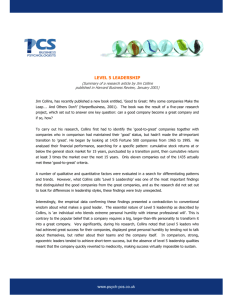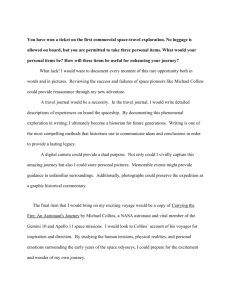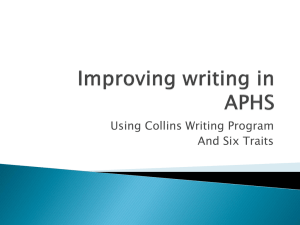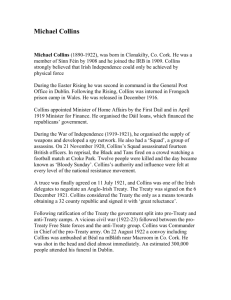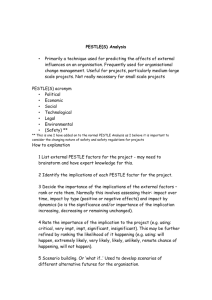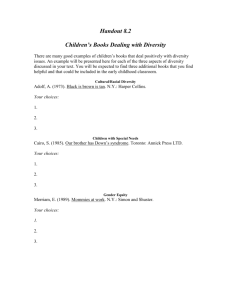PESTLE Analysis: A Graphical Method for Business Environment
advertisement
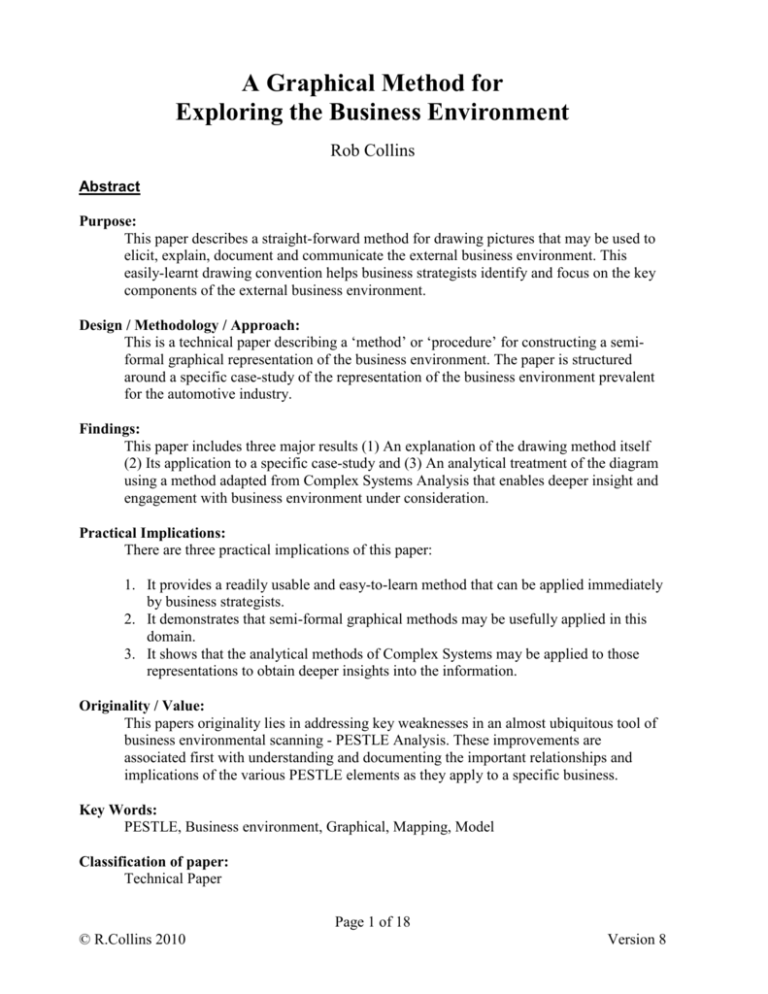
A Graphical Method for Exploring the Business Environment Rob Collins Abstract Purpose: This paper describes a straight-forward method for drawing pictures that may be used to elicit, explain, document and communicate the external business environment. This easily-learnt drawing convention helps business strategists identify and focus on the key components of the external business environment. Design / Methodology / Approach: This is a technical paper describing a ‘method’ or ‘procedure’ for constructing a semiformal graphical representation of the business environment. The paper is structured around a specific case-study of the representation of the business environment prevalent for the automotive industry. Findings: This paper includes three major results (1) An explanation of the drawing method itself (2) Its application to a specific case-study and (3) An analytical treatment of the diagram using a method adapted from Complex Systems Analysis that enables deeper insight and engagement with business environment under consideration. Practical Implications: There are three practical implications of this paper: 1. It provides a readily usable and easy-to-learn method that can be applied immediately by business strategists. 2. It demonstrates that semi-formal graphical methods may be usefully applied in this domain. 3. It shows that the analytical methods of Complex Systems may be applied to those representations to obtain deeper insights into the information. Originality / Value: This papers originality lies in addressing key weaknesses in an almost ubiquitous tool of business environmental scanning - PESTLE Analysis. These improvements are associated first with understanding and documenting the important relationships and implications of the various PESTLE elements as they apply to a specific business. Key Words: PESTLE, Business environment, Graphical, Mapping, Model Classification of paper: Technical Paper Page 1 of 18 © R.Collins 2010 Version 8 1 Introduction It has been argued that when considering the present or future business environment it is not enough simply to identify its key features. Rather, the analyst (often a business strategist) needs to engage in a deep manner with the subject under consideration. “The better we can understand the cause-and-effect associations between the things shaping our business and its markets, the better placed are we to make strategic decisions to ensure effective future performance…In carrying out a PEST or PESTLE analysis it is all too easy to produce lists of factors, many of which may be of little or no importance in developing strategy…Developing a clear understanding of the cause-andeffect relationships between the factors in the PESTLE model is more challenging” Tovstiga and Aylward (2008) In considering future scenarios Wack (1985) has argued: “Good scenarios are not enough. To be effective, they must involve top and middle managers in understanding the changing business environment more intimately than they would in the traditional planning process… Quite simply, [the scenarios] needed structuring…The first-generation scenarios presented the raw uncertainties but they offered no basis on which managers could exercise their judgment.” Indeed, in the original work in which PEST analysis was introduced, Aguilar made explicit the structured nature of the Business Environment Scanning Task (Aguilar, 1967); that is, that there is logic of causal relationships as follows: Figure 1 : Aguilar's Causal Relationships between External Industry Conditions and Areas of Management Attention It is thus perhaps surprising that although PEST / PESTLE analysis is introduced as a key tool for prompting consideration of aspects of the external business environment at all levels of business education, it is frequently presented as a mechanistic, ‘key-word’ driven analysis tool. Thus, it is employed as a handy mnemonic device, leading to a regular, tabular and consequentially formulaic documentation of issues external to the business. It may be made richer through the application of standard questions, or prompts (See Appendix A) but this almost invariably leads to a uni-dimensional analysis. Such an output does not allow the expression of causal relationships between individual environmental issues, and from those issues to the implications for the business. We thus suggest that a more powerful analytical tool, based on the PESTLE tool, might be developed, with the following desirable properties: • To better enable us to understand the cause-and-effect associations between the things shaping our business and its markets Page 2 of 18 © R.Collins 2010 Version 8 • To enable threads of causal relationships to be made explicit to enable more intimate understanding the changing business environment • To provide a ‘tool for thinking’ that enables deep engagement with the subject matter and reasoning about the causes and consequences In looking for a solution that addresses these desirable properties it is natural to consider a graphical interpretation of PESTLE analysis. In that context we can consider the Tversky’s argument: “Graphics have an advantage over language in expressiveness; graphics use elements and relations in graphic space to convey elements and relations in real or metaphoric space. As such, they allow inference based on the visuospatial processing that people have become expert in as part of their everyday interactions with space. As cognitive tools, graphics facilitate reasoning, both by externalising, thus by offloading memory and processing, and by mapping abstract reasoning into spatial comparisons and transformations. Graphics organise and schematize spatial and abstract information to highlight and focus the essential information. Like language, graphics serve to convey spatial and abstract concepts to others. They make private thoughts public to a community that can then use and revise those concepts collaboratively” (Tversky, 2005) Thus in the next section we introduce a diagrammatic convention aimed specifically at modelling the business environment and which addresses these issues. We have named this convention ‘PESTLEWebTM’. We further show an example of how such a diagrammatic representation of the business environment once available, can be treated with ‘transformational’ analytic tools enabling deeper reasoning and insight into the environment under consideration. 2 PESTLEWebTM 2.1 Drawing Conventions At its core PESTLEWebTM is based on the ubiquitous PESTLE tool that is used to support the identification of Political, Economic, Social, Technological, Legal and Ecological issues in the business environment. However, PESTLEWebTM is a drawing convention rather than a tabulated, textual analysis. The base elements of the PESTLEWebTM are a series of boxes labelled to represent each element of the PESTLE analysis. These boxes may be coloured in order to aid identification and differentiation. Those base elements are then joined with directed lines representing the causal relationships between elements. Page 3 of 18 © R.Collins 2010 Version 8 Figure 2 : The Core Elements of the PESTLEWebTM Drawing Convention In order to be useful for analysis, as well as representing PESTLE issues and their causal relationships it is also important to be able to identify the logical consequences of those causal relationships. This is particularly true because to be productive we need analyst to move from an abstract analysis of the business environment to the specific consequences that impinge on their own business. Additionally, it is a common convention in the more formal diagrams of Software Engineering to include drawing elements that enable annotation and comments. Such elements may sit apart from the formal ‘modeling’ (representational) elements of the diagram, but they do afford the human reader to better understand the diagrams. Within the PESTLEWebTM notation we include a generic ‘comment’ symbol, and a specific variant of a comment used to indicate source references for further information. The latter symbol enables the diagram to be embedded within a richer network of source information. Figure 3 : Reference, Comment and Consequence Elements of the PESTLEWebTM Drawing Convention Finally, the convention includes an element to annotate relationships between elements that are not causal in nature. These elements are intended to be less ‘powerful’ in the PESTLEWebTM model that the causal relationship element identified above. Rather than expressing a consequential logic they represent a more generic association between elements. These two types of connectivity between elements (causal and relational) have previously been shown to be Page 4 of 18 © R.Collins 2010 Version 8 useful in a similar context in a previous diagrammatic notation introduced by the author (Collins 1997a ; 1997b) Consider, for example, Figure 4 that shows two elements from a PESTLEWebTM analysis of the automotive industry. The two issues in the diagram are not causally related, but there is an important relationship, or association that the analyst wants to emphasize in the model. This association may be implicit, or the joining line may be labeled explicitly with the nature of the association. Such associations may also be annotated with Comment elements (noting however that comments do not form part of the formal ‘model’ for analytical or ‘transformational’ purposes). Economic Growth in China: most cars < 1.6lt because 60% of car buyers are from middle or low-income households PESTLE Association Technological “Japanese car industry has focused primarily on small fuel efficient cars” PESTLE Figure 4 : Illustration of the use of a Generic Association between Elements in a PESTLEWebTM Diagram 2.2 A PESTLEWebTM Model for the Automotive Industry 2.2.1 Starting the Model This section illustrates the development of a PESTLEWebTM model for the Automotive industry, showing how the model is built section by section. Figure 5 shows an extract from the full model. This shows the consequential chain that leads from car pollution and congestion, through the social and economic consequences of that pollution and on to the political response to those social and economic issues. Note that some of these consequences are economic and some are technological. Page 5 of 18 © R.Collins 2010 Version 8 Figure 5 : Part 1 of a PESTLEWebTM Diagram for the Global Automotive Industry At the bottom right-hand side of Figure 5 we see the final consequence for a specific business that emerges from this causal logic chain. This consequence, of course, would be different depending on the circumstances of the particular business; for an automobile manufacturer producing large, ‘gas-guzzling’ cars, the consequence might be a significant threat. In this example, we have shown the opportunity that may arise for a manufacturer of smaller, fuelefficient engines. 2.2.2 Considering Consequences Figure 6 : Part 2 of a PESTLEWebTM Diagram for the Global Automotive Industry Page 6 of 18 © R.Collins 2010 Version 8 In Figure 6 we see the development a section of the Automotive PESTLEWebTM model that brings together issues of: • The recent credit crisis and its political and hence economic ramifications for the car industry • Social, Economic and Technological factors leading to the US car industry being strongly weighted towards ‘large-car’ manufacture, and • Issues of ‘unintended consequence’ of government support of existing manufacturers One aspect of this diagram should be highlighted to illustrate a general point about PESTLEWebTM models. The ‘Consequence’ element labelled “Reduction (delay) in purchase of new vehicles” could be considered a generic “Economic” issue rather than a “Consequence”; why is it thus so labelled? The answer is that the “Consequence” elements are the link between the general analysis of the Business Environment, and the immediate consequences for the specific business for which the analysis is being performed. In a pure “Industry Analysis” this element might well be labelled as generic “Economic” node. However, in this case we are developing the model from the position of a business that can foresee immediate consequences and implications for their business. In general the “Consequence” elements will feed most directly into later stages of strategic analysis for the business. They will often appear as the ‘Opportunities’ and ‘Threats’ in a later SWOT1 analysis. 2.2.3 Threads ‘Threads’ are series of causally related issues that run through the model. These can be considered as the ‘stories’ that run through the analysis. In other words, each of the PESTLEWebTM elements should be regarded neither as ‘atomic’ nor simply connected to its precursors and consequences. Rather, analysts need to consider ‘threads’ of causally related issues in order to develop a deep understanding of the business environment. Such PESTLEWebTM threads are a close analogue to those introduced by Collins (2000) and are used to explain and analyse behaviour in large-scale, complex systems. The section of the Automotive Industry PESTLEWebTM model in Figure 7 introduces issues associated with the emerging economies and bias in certain countries towards specific types of vehicle. In the full, integrated model elements from this thread cross-linked to elements in the previous threads. The concept of threads is useful in this context because they enable coherent themes to be drawn from the interconnected network of model elements. 1 SWOT : Strengths, Weaknesses, Opportunities and Threats Page 7 of 18 © R.Collins 2010 Version 8 Figure 7 : Part 3 of a PESTLEWebTM Diagram for the Global Automotive Industry Page 8 of 18 © R.Collins 2010 Version 8 3 Transforming PESTLEWebTM Models for Deeper Analysis 3.1 Guide-Word Driven Exploration Evidence from threads analysis in complex systems environments suggests that is it useful to highlight elements and threads and to apply systematic ‘transformations’ on them Collins (2000). Such transformation enable deep intellectual engagement with the subject matter and reveals patterns that would not otherwise be evident. For example, ‘deep’ analysis is afforded through the application of systematic “what if” questions applied to elements within a thread: • What if this issue increased in severity? • What if this issue was reversed in effect? • What if this issue disappeared or became inconsequential? The cognitive overhead associated with addressing such specific ‘what-if’ questions is less than simply asking general questions (E.g. “What is wrong with this diagram” or “What does this diagram tell us?”. In other words, when prompted with specific what-if questions people are more likely to view material from a new and illuminating perspective. “Aha!” moments are not uncommon as analysts change their perspective on the subject matter. They are able to engage more deeply with each element and thread in the context of a specific what-if question. This context is essentially a hypothesis that the analyst can use to challenge the validity (or otherwise) of the specific case. In particular, the analysts looks for possible causes, consequences and implications for the hypothesis being considered. A straight-forward mechanism for developing such directed what-if questions is to use the ‘HAZOP’ technique (Storey, 1996). This technique uses generic guide-words and specific interpretations in the context of specific model element types. Guidewords are fairly universal in different modelling contexts, with only small adaptation to a specific interpretation in a particular context. An example list of guidewords and interpretations in the PESTLEWebTM context are provided in Table 1. This results of this type of systematic analysis are normally tabulated along within information including: 1. Possible cause 2. Possible consequence 3. Probability of occurrence 4. Severity of Effect Table 2 provides a small example of the proposed PESTLEWebTM guide-word driven causeconsequence analysis. Note that as well as prompting insights and deep consideration of the model, its tabular structure enables straight-forward summaries to be developed, for example, the sorting of particular cases by their likelihood and business consequence (i.e. Risk and Opportunities). Page 9 of 18 © R.Collins 2010 Version 8 The structure of the PESTLEWebTM model should itself address some aspects of (1) and (2) above, since it shows threads of causally related issues. However, it is likely that in the course of this analysis, new PESTLE issues will be surfaced that can be added to the model. A negative aspect of such an analysis is that it can become large and effortful to produce. However, in practice it is relatively easy to focus on specific, key issues. The analysis may be conducted either by an individual or as a group activity. Both modes have advantages but it is generally considered that analysis as a group activity is most productive in generating new ideas and insights. Interpretation Example for a ‘Technology’ Element Earlier What would be the situation if this issue arose earlier? Technology becomes available more quickly than expected Later What would be the situation if this issue arose later? Technology becomes available more slowly than expected Not What would be the situation if this issue did not occur, or was negated? Technology is not available Worse What would be the situation if this issue had a more negative consequence than expected? Less effective technology; technology does not achieve the expected results Better What would be the situation if this issue had a more positive consequence than expected? More effective technology; technology achieves better results than expected Other What would be the situation if some other aspect of this issue were the case? Disruptive innovation makes this technology issue Guide Word Table 1 : Guide Words used to Systematically Explore PESTLEWebTM Elements Page 10 of 18 © R.Collins 2010 Version 8 [ Poltical ] Introduction of carbon emmision trading Carbon caps and trading abandonded Cap limits falls later than expected Same effect, different cause. Carbon emmisions Other are lower through some other mechanism Carbon trading functions much Better better than expected. Carbon trading does not function as Worse expected. Cap regime circumvented Not Later Medium Medium Low Very low High Medium Consequence Reduced market for low emmision technology, and technology to 'scrub' emmisions. © R.Collins 2010 Page 11 of 18 Version 8 Need to maintain market share against direct and indirect competitors. Monitor product lifecycle stage. increased competition from new entrants Decreased market demand for our clean engines. 1. Increased market for our products 2. Other solutions become cost effective hence increasing competition Some loss of market. Consider investing and supporting emmision compliance regime - technology, services, training and public awareness Some loss of market. Ensure tracking of political status. Use loggying to support 'green' awareness Catastrophic loss of current business. Therefore need to continually scan for emerging disruptive technologies in energy production Increased market demand for our clean engines. Break even cost for clean enginers lower as it is offset less against carbon cap cost Loss of confidence in emmisions trading Reduced market for low emmision technology, and technology to 'scrub' emmisions. 1. Emergence of disruptive Not necessarily a threat. Could technology that provides increase market awareness of some level of clean energy issues. Part of a growing market. (E.g. Solar /. Wind) Carbon emmisions drop much more quickly than expected, because of economic driving effect of trading Industry discovers that avoidance is cheaper / easier than compliance Market reduces but remains to 2. Political will drains away some extend due to public from ecological issues concerns. Market more driven by energy price 1. Emergence of disruptive technology that provides Catastrophic loss of market for large amounts of cheap, other clean technologies clean energy (E.g. Fusion) Recession causes governements to 'go soft' on carbon caps Decreased market demand for our clean engines. Break even cost for clean enginers higher as it is offset against carbon cap cost Business Implication 14th March 2010 Date 1. Growing public concern Increased market for low emmision of environmental issues technology, and technology to 2. Goverement concern about oil prices and energy 'scrub' emmisions. independence Probability Cause Rob Collins Analyst Table 2 : Example Cause - Consequence Analysis for one Element of the Automotive PESTLEWebTM model 8 7 6 5 4 3 2 1 Guide Transformation Word Item Description Cap limits fall sooner Earlier than expected Automotive Industry model Diagram under Anlaysis PESTLEWeb Cause - Consequence Analysis 0 -4 -4 -4 -6 -10 -5 +5 Implication Score 3.2 Scanning the Business Environment The results of the analysis described in section 3.1 may be usefully summarised in a variety of ways. One objective of such summary data should be to direct the analyst towards those issues in the environment that represent significant threats or opportunities. The assessment of probability and impact in numerical terms (as shown previously) provides the opportunity to produce a scatter plot of the results. Figure 8 shows an example summary scatter plot of a complete cause-consequence analysis for the Automotive Industry example. Such a graphic enables the analyst to focus on the high probability events (points to the right of the plot) and those issues that have a large positive or negative impact on the business (Top-right and bottom-right respectively). The colour coding of this graphic matches that of the original PESTLEWebTM diagram and is intended to enable the analyst to easily build a mental model of where the major threats and opportunities exist in the business environment. Figure 8 simulates an analyst using a customised graphing tool to ‘drill-down’ into data supporting the scatter chart; In this case the pop-up information bubble provides details for the specific issue being highlighted. A key use of Figure 8 is that it enables the analyst and/or business manager to focus on important aspects of the environment. This in turn is intended to direct scanning of the business environment, focussing attention on key information from a ‘noisy’ background. It is this final step then than comes full circle and achieves the ends originally set out by Aguilar’s 1967 text and which is illustrated in Figure 1. Page 12 of 18 © R.Collins 2010 Version 0c (Draft) Environmental Priorities 10 8 6 Economic 4 Impact Political 2 Environmental 0 0 1 2 3 4 5 6 7 8 9 10 Technological -2 Legal -4 Social -6 -8 -10 Probability Figure 8 : Scatter Plot of Results from Complete PESTLEWebTM Cause-Consequence Analysis Page 13 of 18 © R.Collins 2010 Version 0c (Draft) 4 PESTELWebTM Conclusion We have introduced PESTLEWebTM a new, diagrammatic tool for eliciting, exploring, explaining and documenting the logic of the current and future business environment. We have argued that a PESTLEWebTM model is a powerful ‘tool for thinking’ that addresses each of the desirable properties of section 0. Firstly, the cause-and-effect relationships between issues in the business environment are made explicit within PESTLEWebTM models. This thus overcomes one of the major limitations of existing PESTLE analysis. Secondly we have provided some examples of the way in which PESTLEWebTM threads can be identified and documented. We have shown how the relationships between the business environment and a specific business under consideration can be documented. The argument here is that in documenting those relationships the analysts is driven to examine those relationships more rigorously. We have shown that PESTLEWebTM models can be used as a ‘tool for thinking’ by systematically transforming elements with guide-word driven hypothesis to enable deeper engagement and greater insight. This is an analogue of well regarded methods of Systems Engineering and is intended to both challenge existing mind-sets and to suggest alternate realities and consequences Finally, we have shown how the transformational analysis can be graphically summarised to enable easy identification of key focus areas for strategist and business executives when scanning the business environment. The next stage of our work will be to test the PESTLEWebTM tool in the context of actual practice. We hope to build up an evidence base that the proposed tool is more effective and generative in mapping and promoting understanding of the business environment for strategy development. Page 14 of 18 © R.Collins 2010 Version 0c (Draft) References Aguilar, F.J. (1967) “Scanning the Business Environment” The Macmillan Company : New York Collins, R.J. (1997) “The Essential Logic Model: A Method for Documenting Design Rationale in Safety Critical Systems” ESREL ‘97 Collins, R.J. (1997) “A Tutorial on the Essential Logic Model” International Committee on Systems Engineering, UK Conference 1997 Collins, R.J. (2000) “Improving Systems Integrity by Using Thread Analysis for Design Validation” In "A Decade of Progress - A New Century of Opportunity: 10th Annual International INCOSE Symposium Proceedings”, July 16th-20th 2000 Storey, N. (1996) “Safety Critical Computer Systems. 2nd Edn.” Harlow : Pierson Education Tovstiga, G. and Aylward, M. (2008) “Strategic Direction. Study Guide”, Henley Business School Tversky, B. (2005) “Visuospatial Reasoning” in “The Cambridge Handbook of Thinking and Reasoning” K.J. Holyoak and R.G. Morrison (Eds), Cambridge : Cambridge University Press. Wack, P. (1985) “Scenarios: uncharted waters ahead” Harvard Business Review , Sept / Oct Author Biography Rob Collins obtained his first degree in Physics and Computer Science and his PhD in Psychology and Software Engineering. He is a visiting fellow of Kellogg College Oxford and teaches post-graduate courses at the University of Oxford in Safety Critical Systems and LargeScale, Complex Systems Engineering. He is currently studying for an MBA at Henley Business School Acknowledgments I would like to thank Professor Francis Aguilar of Harvard University for supplying me a copy of his seminal work on Scanning the Business environment. I would also like to thank the Henley Business School, Picasso team for their critical assessment and contribution to the automotive PESTLEWebTM model presented in this paper. Page 15 of 18 © R.Collins 2010 Version 0c (Draft) Figure 9 : The Complete PESTLEWebTM Model for the Global Automotive Industry Page 16 of 18 © R.Collins 2010 Version 0c (Draft) Appendix A : Typical PEST Checklist Political • • • • • • • • • • Political stability Risk of military invasion Legal framework for contract enforcement Intellectual property protection Trade regulations &amp; tariffs Favored trading partners Anti-trust laws Pricing regulations Taxation - tax rates and incentives Work week • • • • • • • • Wage legislation minimum wage and overtime Mandatory employee benefits Industrial safety regulations Product labeling requirements Ecological/environmental legislation Current legislation Future legislation International legislation • Labor costs Economic growth rate Discretionary income Unemployment rate Inflation rate Interest rates Home economy Economy trends Overseas economies General taxation Business cycle stage (e.g. Prosperity, recession, recovery) • • • • • • • • Regulatory bodies and processes Government policies Government term and change Trading policies Funding, grants and initiatives Home market pressure groups International pressure groups Wars and conflicts Economic • • • • • • • Type of economic system in countries of operation Government intervention in the free market Comparative advantages of host country Exchange rates &amp; stability of host country currency Efficiency of financial markets Infrastructure quality Skill level of workforce • • • • • • • • • • • • • • • • • • • Taxation specific to product/services Seasonality issues Market/trade cycles Specific industry factors Market routes trends Distribution trends Customer/end-user drivers Interest/ exchange rates International trade and Monetary issues Page 17 of 18 © R.Collins 2010 Version 0c (Draft) Social • • • • • • • Demographics Class structure Education Culture (gender roles, etc.) Entrepreneurial spirit Attitudes (health, environmental consciousness, etc.) Leisure interests • • • • • • • Lifestyle trends Demographics Consumer attitudes and opinions Media views Law changes affecting social factors Brand Consumer buying patterns • • • • • • Fashion and role models Major events and influences Buying access and trends Ethnic/religious factors Advertising and publicity Ethical issues Research funding Associated and dependent technologies Replacement technology/solutions Maturity of technology Manufacturing maturity and capacity Information and communications • • • • • • • Consumer buying Mechanisms/technology Technology legislation Innovation potential Technology access Licensing, patents Intellectual property issues Technological • • • • • • Recent technological developments Technology's impact on product offering Impact on cost structure Impact on value chain structure Rate of technological diffusion Competing technology • • • • • • Page 18 of 18 © R.Collins 2010 Version 0c (Draft)
